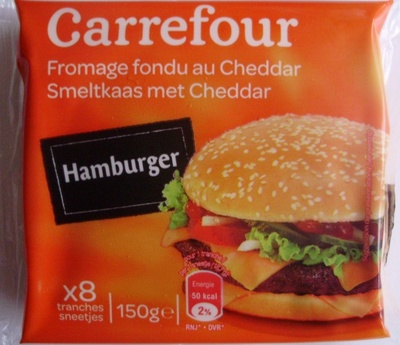Fromage fondu au Cheddar (21 % MG) - Carrefour - 150 g (8 tranches)
Important note: this product is no longer sold. The data is kept for reference only. This product does not appear in regular searches and is not taken into account for statistics.
This product page is not complete. You can help to complete it by editing it and adding more data from the photos we have, or by taking more photos using the app for Android or iPhone/iPad. Thank you!
×
Some of the data for this product has been provided directly by the manufacturer Carrefour.
Barcode: 3560070283361 (EAN / EAN-13)
Common name: Fromage industriel de France, fondu, au lait de vache, en tranches
Quantity: 150 g (8 tranches)
Packaging: Bag, Fresh, Individual bag, Protective gas, fr:Sachet plastique
Brands: Carrefour, CMI (Carrefour Marchandises Internationales), Groupe Carrefour
Categories: Dairies, Fermented foods, Fermented milk products, Cheeses, Cow cheeses, Fresh foods, French cheeses, Sliced cheeses, Industrial cheese, Melted cheese
Labels, certifications, awards:
Distributor labels, Carrefour Quality, Green Dot, Made in France, fr:Eco-Emballages
Manufacturing or processing places: Entremont Alliance - EA (Filiale Sodiaal International) - Usine Sainte-Catherine - 22 Rue de la Césière - ZI de Vovray - 74000 Annecy, Haute-Savoie, Rhône-Alpes, France
Traceability code: FR 74.010.061 CE - Annecy (Haute-Savoie, France), EMB 74010 - Annecy (Haute-Savoie, France)
Stores: Carrefour market, Carrefour
Countries where sold: France
Matching with your preferences
Environment
Carbon footprint
Packaging
Transportation
Report a problem
Data sources
Product added on by openfoodfacts-contributors
Last edit of product page on by org-carrefour.
Product page also edited by jacob80, jeremy64, manu1400, packbot, teolemon, teymour.










